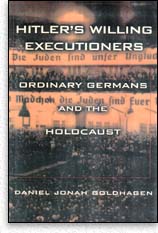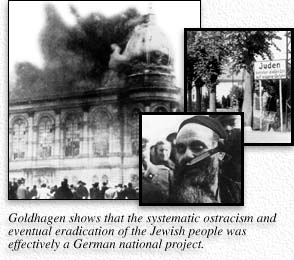




any books have been described as “controversial.” But few in recent years have been as deserving of that description as Daniel Goldhagen’s Hitler’s Willing Executioners. It has created international controversy and yet remained a bestseller in Germany, the country which, as a whole, is central to its premise—even though that premise is hardly flattering to people and things German.
There may be many reasons for this. But, as columnist Jerry Adler has noted, “Germany has a vast appetite for Holocaust history.” And this book is unusual in that it focuses on—and refutes—the oft-heard tale that the Holocaust-era atrocities were solely the work of the Nazis and the SS.
It almost goes without saying that the round-up and slaughter of six million people could not have been carried out in a few years, no matter what the efficiency, by an army numbering only in the tens of thousands. Goldhagen shows that the eradication of Jews was effectively a German national project.
He also examines and answers the question of how the German populace came to accept this “project” and became willing, even eager participants in it.
“I would also like to say that it did not at all occur to me that these orders could be unjust,” says Kurt Mobius, former German police battalion member, in the pages of Hitler’s Willing Executioners. “It is true that I know that it is also the duty of the police to protect the innocent, but I was then of the conviction that the Jews were not innocent but guilty. I believed the propaganda that all Jews were criminals and subhumans and that they were the cause of Germany’s decline after the First World War.”
Goldhagen’s examination of that campaign of propaganda is unique in its detail. “In Germany, during the Nazi period,” he writes, “putative Jewish evil permeated the air. It was discussed incessantly. It was said to be the source of every ill that had befallen Germany and of every continuing threat.”
He notes that the central qualities of German antisemitic propaganda included “its hallucinatory image of the Jews; the specter of evil that they appeared to Germans to be casting over Germany; Germans’ virulent hatred of them; the ‘abstract’ character of the beliefs that informed the treatment which its bearers accorded real Jews; the unquestioned nature of these beliefs; and the eliminationist logic that led Germans to approve of the persecution, ghettoization, and extermination of Jews (the evident meaning of the euphemism ‘made harmless’).”
The real value of any work of historical analysis lies in what it can teach us about the past so that it might be learned from—and, sometimes, so that similar events and mistakes might be avoided. It is in this regard, and in examining Germany today, that Goldhagen’s book provides real insight.
He analyzes the evolution of anti-Jewish social policy:
“Distilling the essence from the broad array of the Germans’ policies towards German and European Jews reveals that the policies shared two important features and objectives:
“1. To turn the Jews into ‘socially dead’ beings—beings that were violently dominated, natally alienated, and generally dishonored—and, once they were, to treat them as such.
“2. To remove the Jews as thoroughly and permanently from social and, as far as possible, from physical contact with the German people, and thereby to neutralize them as a factor in German life.
“These two factors were constant components of the Germans’ Jewish policy, whatever the actual measures were. The belief in the desirability of these goals composed the anti-Jewish policy’s axioms, its underlying cognitive model.
“The implementation of these objectives included a number of changing policies and measures, some of which overlapped temporally. They included:
1. Verbal assault.
2. Physical assault.
3. Legal and administrative measures to isolate Jews from non-Jews.
4. Driving them to emigrate.
5. Forced deportation and “resettlement.”
6. Physical separation in ghettos.
7. Killing through starvation, debilitation, and disease (prior to the formal genocidal program).
8. Slave labor as a surrogate for death.
9. Genocide, primarily by means of mass shootings, calculated starvation, and gassing.
10. Death marches.”
In examining current events in Germany, minorities subject to government-sanctioned persecution have seen the reenactment of points one through five above, sometimes with subtle variations; and, while those under assault today almost certainly don’t believe that matters would advance to the latter points, Goldhagen points out that the Jews of the 1930s also didn’t believe that such sinister acts were truly possible. Elie Wiesel has told of how his father assured him, even while they were together in Auschwitz, that the worst that would befall them would be forced slave labor. Wiesel’s father was murdered shortly thereafter. Such accounts—and they are numerous—make this point even more forcefully.
In chapter 16, “Eliminationist Antisemitism as Genocidal Motivation,” he touches on another aspect of the 1930s climate which is present again today, though in a slightly different incarnation: the role of the established Christian churches in Germany in carrying forward policies of persecution.
 The Protestant (Lutheran) Church disseminated antisemitic views weekly through religious periodicals, such as the Sonntagsblatter. They preached that the Jews were the “natural enemies of the Christian-national tradition,” and that they had caused “the collapse of the Christian and monarchical order.”
The Protestant (Lutheran) Church disseminated antisemitic views weekly through religious periodicals, such as the Sonntagsblatter. They preached that the Jews were the “natural enemies of the Christian-national tradition,” and that they had caused “the collapse of the Christian and monarchical order.”
Goldhagen writes that, “In March 1941, by which time Germans had already inflicted enormous harm on the Jews of Germany and Europe, [Catholic] Archbishop Konrad Grober published a pastoral letter replete with antisemitism. He placed the blame upon the Jews for the death of Jesus, which he implied justified what Germans were then doing to the Jews: ‘The self-imposed curse of the Jews, “His blood be upon us and upon our children,” has come true terribly until the present time, until today. ‘ Grober was anything but a solitary anti-Jewish figure in the Catholic Church. . . .”
Goldhagen also cites praise heaped on the Nazis by Lutheran clergy on the anniversary of Martin Luther’s birthday, November 10, 1938, for “the synagogues [were] burning in Germany [that day].” November 9-10, 1938 was the infamous Kristallnacht.
But he also quotes a stirring and insightful letter from Pastor Walter Hochstader, one of the few clergymen to speak out:
“Today the Jew-hating madness, which had already raged frightfully in the Middle Ages, has entered upon its acute stage. This, the Church, the community of Jesus Christ, must acknowledge. If she does not do it, then she will have failed, just as she failed then, during the time of the witch hunts.”
Though written in 1944—too late to be talking of the Church’s failure at that time—his letter sends a compelling message for those who lead the Lutheran and Catholic Churches in Germany today, who participate in or condone a new era of intolerance against minorities.
In concluding his letter, Hochstader writes that “The Church ought to live of love. Woe to her if she does not do that! Woe to her if by her silence and by all sorts of dubious excuses she becomes jointly guilty of the world’s outbursts of hatred! Woe to her if she adopts words and slogans that originate in the sphere of hatred.”
For these words and much other information in Goldhagen’s book, and its relevance to understanding and averting repetition of the errors of history, Hitler’s Willing Executioners, now in its 11th printing, is highly revelatory and 

